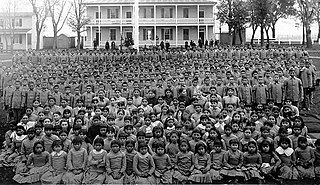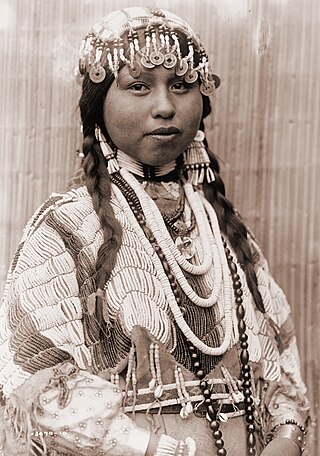Related Research Articles

The Dawes Act of 1887 regulated land rights on tribal territories within the United States. Named after Senator Henry L. Dawes of Massachusetts, it authorized the President of the United States to subdivide Native American tribal communal landholdings into allotments for Native American heads of families and individuals. This would convert traditional systems of land tenure into a government-imposed system of private property by forcing Native Americans to "assume a capitalist and proprietary relationship with property" that did not previously exist in their cultures. The act allowed tribes the option to sell the lands that remained after allotment to the federal government. Before private property could be dispensed, the government had to determine which Indians were eligible for allotments, which propelled an official search for a federal definition of "Indian-ness."

The Indian Reorganization Act (IRA) of June 18, 1934, or the Wheeler–Howard Act, was U.S. federal legislation that dealt with the status of American Indians in the United States. It was the centerpiece of what has been often called the "Indian New Deal". The major goal was to reverse the traditional goal of cultural assimilation of Native Americans into American society and to strengthen, encourage and perpetuate the tribes and their historic Native American cultures in the United States.

Tribal sovereignty in the United States is the concept of the inherent authority of Indigenous tribes to govern themselves within the borders of the United States.

The Oklahoma Indian Welfare Act of 1936 is a United States federal law that extended the 1934 Wheeler-Howard or Indian Reorganization Act to include those tribes within the boundaries of the state of Oklahoma. The purpose of these acts were to rebuild Indian tribal societies, return land to the tribes, enable tribes to rebuild their governments, and emphasize Native culture. These Acts were developed by John Collier, Commissioner of Indian Affairs from 1933 to 1945, who wanted to change federal Indian policy from the "twin evils" of allotment and assimilation, and support Indian self-government.

Santa Fe Indian School (SFIS) is a tribal boarding secondary school in Santa Fe, New Mexico. It is affiliated with the Bureau of Indian Education (BIE).

The Indian Health Service (IHS) is an operating division (OPDIV) within the U.S. Department of Health and Human Services (HHS). IHS is responsible for providing direct medical and public health services to members of federally recognized Native American Tribes and Alaska Native people. IHS is the principal federal health care provider and health advocate for Indian people.
The Oneida Nation is a federally recognized tribe of Oneida people in Wisconsin. The tribe's reservation spans parts of two counties west of the Green Bay metropolitan area. The reservation was established by treaty in 1838, and was allotted to individual New York Oneida tribal members as part of an agreement with the U.S. government. The land was individually owned until the tribe was formed under the Indian Reorganization Act of 1934.

A series of efforts were made by the United States to assimilate Native Americans into mainstream European–American culture between the years of 1790 and 1920. George Washington and Henry Knox were first to propose, in the American context, the cultural assimilation of Native Americans. They formulated a policy to encourage the so-called "civilizing process". With increased waves of immigration from Europe, there was growing public support for education to encourage a standard set of cultural values and practices to be held in common by the majority of citizens. Education was viewed as the primary method in the acculturation process for minorities.
Indian termination is a phrase describing United States policies relating to Native Americans from the mid-1940s to the mid-1960s. It was shaped by a series of laws and practices with the intent of assimilating Native Americans into mainstream American society. Cultural assimilation of Native Americans was not new; the belief that indigenous people should abandon their traditional lives and become what the government considers "civilized" had been the basis of policy for centuries. What was new, however, was the sense of urgency that, with or without consent, tribes must be terminated and begin to live "as Americans." To that end, Congress set about ending the special relationship between tribes and the federal government.

The Civilization Fund Act, also known as the Indian Civilization Act, was an Act passed by the United States Congress on March 3, 1819. The Act encouraged activities of benevolent societies in providing education for Native Americans and authorized an annuity to stimulate the "civilization process". Thomas L. McKenney lobbied Congress in support of the legislation. It was originally intended to support schools in native villages and areas, such as those established by religious missions. These were operated by both Protestant and Catholic organizations. In 1891 through the early 20th century, the government used the Civilization Fund Act as authority to establish numerous Native American boarding schools.
The Meriam Report (1928) was commissioned by the Institute for Government Research and funded by the Rockefeller Foundation. The IGR appointed Lewis Meriam to be the technical director of the survey team to compile information and report on the conditions of American Indians across the country. Meriam submitted the 847-page report to the Secretary of the Interior, Hubert Work, on February 21, 1928.

The Indian Self-Determination and Education Assistance Act of 1975 authorized the Secretary of the Interior, the Secretary of Health, Education, and Welfare, and some other government agencies to enter into contracts with, and make grants directly to, federally recognized Indian tribes. The tribes would have authority for how they administered the funds, which gave them greater control over their welfare. The ISDEAA is codified at Title 25, United States Code, beginning at section 5301.

American Indian boarding schools, also known more recently as American Indian residential schools, were established in the United States from the mid-17th to the early 20th centuries with a primary objective of "civilizing" or assimilating Native American children and youth into European American culture. In the process, these schools denigrated Native American culture and made children give up their languages and religion. At the same time the schools provided a basic Western education. These boarding schools were first established by Christian missionaries of various denominations. The missionaries were often approved by the federal government to start both missions and schools on reservations, especially in the lightly populated areas of the West. In the late 19th and early 20th centuries especially, the government paid religious orders to provide basic education to Native American children on reservations, and later established its own schools on reservations. The Bureau of Indian Affairs (BIA) also founded additional off-reservation boarding schools based on the assimilation model. These sometimes drew children from a variety of tribes. In addition, religious orders established off-reservation schools.

The Indian Relocation Act of 1956 was a United States law intended to create a "a program of vocational training" for Native Americans in the United States. Critics characterize the law as an attempt to encourage Native Americans to leave Indian reservations and their traditional lands, to assimilate into the general population in urban areas, and to weaken community and tribal ties. Critics also characterize the law as part of the Indian termination policy between 1940 and 1960, which terminated the tribal status of numerous groups and cut off previous assistance to tribal citizens. The Indian Relocation Act encouraged and forced Native Americans to move to cities for job opportunities. It also played a significant role in increasing the population of urban Native Americans in succeeding decades.

The Native American Languages Act of 1990 is the short cited title for executive order PUBLIC LAW 101-477 enacted by the United States Congress on October 30, 1990. Public Law 101-477 of 1990 gave historical importance as repudiating past policies of eradicating Indian Languages by declaring as policy that Native Americans were entitled to use their own languages. The fundamental basis of the policy's declaration was that the United States "declares to preserve, protect and promote the rights and freedom of Native Americans to use practice and develop Native American Languages".

The Enabling Act of 1906, in its first part, empowered the people residing in Indian Territory and Oklahoma Territory to elect delegates to a state constitutional convention and subsequently to be admitted to the union as a single state.

An Organic Act is a generic name for a statute used by the United States Congress to describe a territory, in anticipation of being admitted to the Union as a state. Because of Oklahoma's unique history an explanation of the Oklahoma Organic Act needs a historic perspective. In general, the Oklahoma Organic Act may be viewed as one of a series of legislative acts, from the time of Reconstruction, enacted by Congress in preparation for the creation of a united State of Oklahoma. The Organic Act created Oklahoma Territory, and Indian Territory that were Organized incorporated territories of the United States out of the old "unorganized" Indian Territory. The Oklahoma Organic Act was one of several acts whose intent was the assimilation of the tribes in Oklahoma and Indian Territories through the elimination of tribes' communal ownership of property.

The Native American peoples of Oregon are the set of Indigenous peoples who have inhabited or who still inhabit the area delineated in today's state of Oregon in the Pacific Northwest region of the United States. While the state of Oregon currently maintains relations with nine federally recognized tribal groups, the state was previously home to a much larger number of autonomous tribal groups, which today either no longer exist or have been absorbed into these larger confederated entities. Six of the nine tribes gained federal recognition in the late 20th century, after undergoing the termination and restoration of their treaty rights starting in the 1950s.
Both Oklahoma Territory and Indian Territory contained suzerain Indian nations that had legally established boundaries. The US federal government allotted collective tribal landholdings through the allotment process before the establishment of Oklahoma as a state in 1907. Tribal jurisdictional areas replaced the tribal governments, with the exception of the Osage Nation. As confirmed by the Osage Nation Reaffirmation Act of 2004, the Osage Nation retains mineral rights to their reservation, the so-called "Underground Reservation".
The administration of Richard Nixon, from 1969 to 1974, made important changes in United States policy towards Native Americans through legislation and executive action. The Nixon Administration advocated a reversal of the long-standing policy of "termination" that had characterized relations between the U.S. Government and American Indians in favor of "self-determination." The Alaska Native Claims Settlement Act restructured indigenous governance in the state of Alaska, creating a unique structure of Native Corporations. Some of the most notable instances of American Indian activism occurred under the Nixon Administration including the Occupation of Alcatraz and the Standoff at Wounded Knee.
References
- ↑ James Stuart Olson; Raymond Wilson (1986). Native Americans in the Twentieth Century. University of Illinois Press. pp. 113–15. ISBN 9780252012853.
- 1 2 Sokolow, Gary A. (2000) Native Americans and The Law: A Dictionary. Santa Barbara, CA:ABC-CLIO
- ↑ Sharpes, Donald K. "Federal Education for the American Indian" Journal of American Indian Education. 19 (1) 1979 October
- ↑ Price, Monroe E. (1973) Law and the American Indian: Readings, Notes and Cases. Indianapolis, Kansas City, and New York: the Bobbs-Merrill Company, Inc.